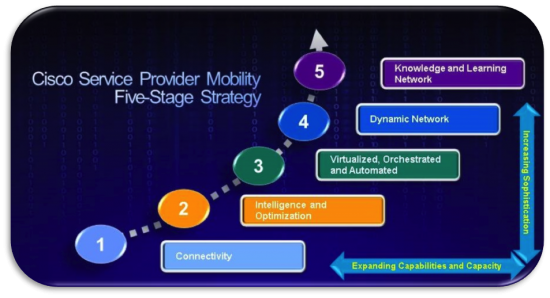































 Written By Dan Kurschner, Senior Manager SP Mobility Marketing
Written By Dan Kurschner, Senior Manager SP Mobility Marketing
Over the past decades, Mobility has advanced from a mere curiosity (remember those "brick" phones?), to a convenience and today being an indispensable part of our everyday lives. Businesses are leveraging the internet and the cloud to deliver new services and capabilities -via the mobile network. While we can access the internet and cloud-based services from almost anywhere, most people do so with barely a thought of the complexities it takes to deliver this ubiquitously connected experience.
Mobile service providers have long been building and upgrading their networks to meet growing demand for capacity and capabilities to stay competitive. Recently, a new type of competitor has emerged to threatenthe mobile service provider's value-chain; the pure-play hosted-cloud providers. Both enterprise and individual subscribers access cloud-based services to be connected with their data via any device, anywhere, and also to simply off-load the expense and complexity of running that capability themselves. While these services are accessed via the mobile network, the mobile service provider is pushed to a lower ring on the value-chain as simply a "dumb pipe". Mobile service provider's need find a way to compete with pure-play cloud providers while advancing their own networks.

Relatively speaking, the pure-play cloud service provider has a less complex task. They need to manage their data centers and remain agile enough provide new capabilities as fast as the market demands ("web-speed"). While this is no small feat, the mobile service provider has a greater challenge since they must evolve their complex network to compete and deliver their own cloud-based services at "Web-Speed". However, the mobile service provider that successfully meets this challenge can actually deliver a better experience as they will control all aspects of the service, security and delivery experience. By doing this, they move up the value chain and can take advantage of important revenue opportunities.
So how does the mobile service provider evolve to simultaneously grow capacity and add new capabilities while keeping a lid on the inevitable growing complexities of this network?
To meet the growing demand for capacity, capabilities and agility, mobile service providers are looking to add intelligence and agility while reducing costs. They are looking to virtualization (NfV) and SDN to make this a reality ( www.cisco.com/go/epn ). The successful mobile service provider will quickly understand in order to achieve their goals using NfV and SDN they must orchestrate and manage the physical and virtualized components as a single network (not layered or paralleled and certainly not in silos). This orchestrated network of physical and virtualized solutions will operate with increasing intelligence gleaned from analytics and leverage dynamic capabilities to offer their customers greater customization opportunities while increasing the agility of delivering new services and controlling complexities.

Cisco recognizes this evolution and the opportunities as well as the challenges andaddresses these with a five-stage strategy. This strategy was initially shared with select guests at the 2014 Mobile World Congress in Barcelona, Spain. We have since broadened the audience and are now sharing this via a series of papers. The first of these papers is an overview and introduction to this five-stage strategy and can be found here. In the next couple of months additional papers will be released going into increasing detail of this strategy and the value it brings to the mobile service provider.
 Hot Tags :
Service Provider
Mobile
SDN
Virtualization
Networks
nfv software defined network
Hot Tags :
Service Provider
Mobile
SDN
Virtualization
Networks
nfv software defined network